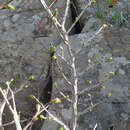fi
nimet breadcrumb-navigoinnissa


Ulmus macrocarpa Hance, the large-fruited elm, is a deciduous tree or large shrub endemic to the Far East excluding Japan. It is notable for its tolerance of drought and extreme cold and is the predominant vegetation on the dunes of the Khorchin sandy lands in the Jilin province of north-eastern China, making a small tree at the base of the dunes, and a shrub at the top [4].
By the age of ten years, the tree bears a close resemblance to the American elm U. americana, but will never approach the latter's size. The tree can reach a height of 17 m, with a slender trunk rarely exceeding 0.4 m d.b.h; the bark is longitudinally fissured, and dark grey in colour. The twigs often develop corky wings that may persist for several years. The leaves are usually obovate < 9 cm long by 5 cm broad[2] (significantly smaller on juvenile trees) and chiefly characterized by their thick, leathery texture and obtusely doubly or simply toothed margins. The perfect, wind-pollinated apetalous flowers appear from March until May. As implied by its name, U. macrocarpa is distinguished by its large, orbicular, wafer-like samarae < 50 mm in diameter, which ripen in May and June.[3][4]
Possessed of a moderate resistance to Dutch elm disease and a low susceptibility to elm yellows, it has also proven very resistant to the elm leaf beetle Xanthogaleruca luteola in trials in Oklahoma [5] and Italy.[5]
U. macrocarpa was introduced to the UK at Aldenham House in Hertfordshire in the late 19th century by Vicary Gibbs (1853–1932),[6] almost certainly as part of the quincunx elm avenue leading to the front of the house.[7] The tree was propagated and marketed in the UK by the Hillier & Sons nursery, Winchester, Hampshire, from 1949, with 47 sold from 1962 to 1977. [8][9]
The tree was introduced to the United States at the Arnold Arboretum, Massachusetts, in 1908. It has been assessed at the Morton Arboretum, Illinois, for its landscape potential, and is now considered suitable for open areas such as parks and campuses.[10] Typically, U. macrocarpa is intolerant of poorly drained ground prone to waterlogging, but has been found to be the most cold hardy of the Chinese elms in artificial freezing tests at the Morton Arboretum, the LT50 (temp. at which 50% of tissues die) was - 36 °C.[11]
Two varieties are recognized: var. glabra Nie & Huang and var. macrocarpa L.K.Fu
A natural hybrid of U. macrocarpa and U. davidiana var. japonica, named Ulmus × mesocarpa was discovered in South Korea in the 1980s. U. macrocarpa is believed to have been used in recent (post 2000) hybridization experiments at the Morton Arboretum [5] but results have yet (2008) to be published. There are no known cultivars of this taxon.
Ulmus macrocarpa Hance, the large-fruited elm, is a deciduous tree or large shrub endemic to the Far East excluding Japan. It is notable for its tolerance of drought and extreme cold and is the predominant vegetation on the dunes of the Khorchin sandy lands in the Jilin province of north-eastern China, making a small tree at the base of the dunes, and a shrub at the top [4].
Ulmus macrocarpa là một loài thực vật có hoa trong họ Ulmaceae. Loài này được Hance miêu tả khoa học đầu tiên năm 1868.[1]
Ulmus macrocarpa là một loài thực vật có hoa trong họ Ulmaceae. Loài này được Hance miêu tả khoa học đầu tiên năm 1868.
Ulmus macrocarpa Hance
Вяз крупноплодный (лат. Ulmus macrocarpa) — лиственное дерево, вид рода Вяз (Ulmus) семейства Вязовые (Ulmaceae).
В природе ареал вида охватывает Восточную Сибирь (Читинская область), Приморье, Монголию, Корейский полуостров и северо-восточные районы Китая[2].
Произрастает по лесистым склонам, в долинах рек, скаловым россыпям, на каменистых и скалистых склонах; одиночно или группами.
Небольшое дерево (высотой до 8 м) или кустарник с серой, бурой или желтоватой корой и опушенными молодыми веточками.
Почки конические. Листья широко-обратнояйцевидные, длиной 7—9 см, шириной 5 см, с клиновидным неравнобоким основанием, заострённой верхушкой, по краю удвоенно-пильчатые.
Плод — широкоэллиптическа крылатка длиной 3—3,5 см и шириной до 2,5 см, по всей поверхности щетинистая, с орешком, расположенным в центре крыла и отделенным от верхней выемки швом в 9—10 мм.
Цветение в апреле. Плодоношение в июне.
Вид Вяз крупноплодный входит в род Вяз (Ulmus) семейства Вязовые (Ulmaceae) порядка Розоцветные (Proteales).
Вяз крупноплодный (лат. Ulmus macrocarpa) — лиственное дерево, вид рода Вяз (Ulmus) семейства Вязовые (Ulmaceae).
大果榆(学名:Ulmus macrocarpa)为榆科榆属的植物。分布在朝鲜、俄罗斯中部以及中国大陆的安徽、吉林、甘肃、山西、山东、河南、辽宁、青海、陕西、黑龙江、河北、江苏、内蒙古等地,生长于海拔700米至1,800米的地区,多生长在黄土丘陵、台地、山坡、谷地、固定沙丘及岩缝中,目前尚未由人工引种栽培。
芜荑(神农本草经) 姑榆(尔雅) 山松榆(说文) 山榆(广雅) 白芜荑(圣惠方) 黄榆(中国经济植物志) 迸榆(河北) 扁榆、柳榆(河南) 山扁榆(辽宁熊岳) 翅枝黄榆、倒卵果黄榆、广卵果黄榆、蒙古黄榆、矮形黄榆(东北木本植物图志)
[1] 照片1
Straybird726, 中文(新加坡): 粗糙的大果榆叶片上的一种昆虫的家 Q30014757 Baihuashan National Natural Reserve 拍摄于北京百花山国家级自然保护区 straybird726@163.com, 2017-05-24 [2017-06-07]
大果榆(学名:Ulmus macrocarpa)为榆科榆属的植物。分布在朝鲜、俄罗斯中部以及中国大陆的安徽、吉林、甘肃、山西、山东、河南、辽宁、青海、陕西、黑龙江、河北、江苏、内蒙古等地,生长于海拔700米至1,800米的地区,多生长在黄土丘陵、台地、山坡、谷地、固定沙丘及岩缝中,目前尚未由人工引种栽培。
왕느릅나무는 한국의 중부 이북의 산기슭에 나는 낙엽교목으로 작은 가지에 코르크가 발달해 있다. 잎은 어긋나며 넓은 거꿀달걀형, 끝이 아주 뾰족해지고, 길이는 3.5-15.5cm이다. 양면이 깔깔하고, 가장자리에 이 모양의 예리한 톱니가 있다. 꽃은 다발로 모인 취산꽃차례를 이루며 열매는 시과, 넓은 거꿀달걀형이며 단모와 선모가 있다. 씨는 날개의 밑부분에 몰려 있다. 개화기는 5월 결실기는 6-7월이고, 목재는 신탄재로, 껍질은 약용으로 쓰이며 관상용으로 심는다.